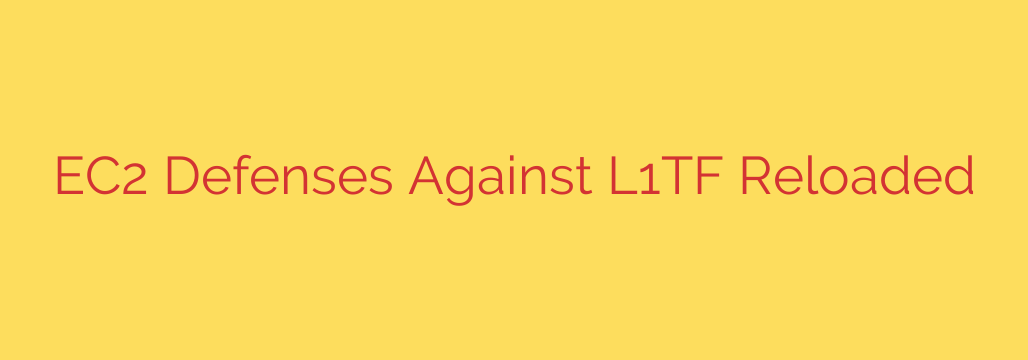
Securing Your Cloud: Understanding and Mitigating L1TF on AWS EC2
In the world of cloud computing, security is paramount. While we benefit from the incredible power and scalability of platforms like Amazon EC2, it’s crucial to understand the underlying hardware and the potential vulnerabilities that come with it. One of the most significant threats to emerge in recent years is a class of processor vulnerability known as a side-channel attack.
A prime example is the L1 Terminal Fault (L1TF), a hardware vulnerability affecting certain Intel processors. This issue specifically targets the speculative execution processes that modern CPUs use to enhance performance. While these attacks are complex, understanding them is the first step toward building a robust defense for your cloud infrastructure.
What is the L1 Terminal Fault (L1TF) Vulnerability?
At its core, L1TF is a security flaw that could potentially allow a malicious actor to read data from a location they shouldn’t have access to. In a cloud environment, the primary concern is that a process running in one virtual machine (VM) could gain unauthorized access to data from another VM hosted on the same physical server.
The vulnerability exploits a feature called speculative execution. To speed things up, a CPU often “guesses” what instructions it will need to run next and executes them ahead of time. If the guess is wrong, it discards the results. However, the L1TF flaw creates a tiny window where the side effects of this speculative execution can be observed, potentially leaking sensitive information stored in the processor’s L1 data cache.
For cloud providers who rely on multi-tenancy—hosting multiple customers on a single piece of hardware—a vulnerability like L1TF is a serious concern.
The Key Factor: Hyper-Threading (SMT)
A critical component of the L1TF vulnerability is Simultaneous Multithreading (SMT), more commonly known by Intel’s brand name, Hyper-Threading. SMT allows a single physical processor core to function as two logical cores (vCPUs in EC2 terminology). These two logical cores share resources, including the L1 cache.
This resource sharing is the primary vector for the L1TF attack. A malicious process running on one logical core could potentially use the L1TF flaw to access data being handled by the other logical core on the same physical core. This breaks the fundamental isolation that is expected between different customer instances.
How AWS Protects Your EC2 Instances from L1TF
Protecting a massive, global infrastructure like AWS requires a multi-layered defense strategy. AWS has implemented comprehensive measures to mitigate L1TF and similar vulnerabilities at every level.
A Secured Hypervisor: All modern EC2 instances run on the AWS Nitro System, which includes a lightweight, security-focused hypervisor. AWS has patched its hypervisor to prevent cross-VM data access via L1TF. This foundational layer of protection is automatically in place for all customers and ensures that one EC2 instance cannot use this vulnerability to read the memory of another.
Intelligent Instance Placement: AWS has updated its EC2 instance schedulers. When a new instance is launched, the scheduler ensures it is placed on a host that is fully patched and protected. By default, your instances are protected from other instances you don’t own.
Customer-Controlled Security: While AWS secures the underlying infrastructure, the shared responsibility model means you also have a role to play. For workloads with the highest security requirements, AWS provides customers with direct control over Hyper-Threading.
Actionable Security: When and How to Disable Hyper-Threading
For most workloads, the default protections provided by AWS are sufficient. However, if you are running highly sensitive applications or need to meet strict compliance standards, you may consider disabling SMT.
The main defense you can control is to ensure that no untrusted code runs on a sibling thread of the same physical core. The most straightforward way to achieve this is by disabling Hyper-Threading for your EC2 instance.
Here’s what you need to know:
- Performance vs. Security: Disabling SMT is a trade-off. You gain an additional layer of security by eliminating the shared core resource vector, but you may see a performance impact on applications that are heavily multi-threaded. It’s essential to test your specific workload before and after making this change to understand its effect.
- How to Disable SMT: You can disable Hyper-Threading on a per-instance basis during launch. This is done by specifying the number of CPU cores and setting the threads per core to 1. For example, instead of launching an instance with 8 vCPUs (representing 4 cores with SMT enabled), you would configure it to launch with 4 cores and 1 thread per core.
- Instance Type Matters: The ability to disable SMT is available on most modern, Nitro-based EC2 instances. Always check the documentation for your chosen instance family to confirm support.
Beyond L1TF: A Holistic Approach to Security
While processor-level vulnerabilities get a lot of attention, they are just one piece of the security puzzle. A comprehensive security posture includes:
- Regular Patching: Always keep your guest operating systems and application software up-to-date with the latest security patches.
- Network Security: Utilize Security Groups and Network Access Control Lists (NACLs) to enforce the principle of least privilege, allowing only necessary traffic to and from your instances.
- Identity and Access Management (IAM): Use IAM roles with finely-tuned permissions for your EC2 instances instead of storing long-term credentials on them.
- Monitoring and Logging: Actively monitor your environment with tools like AWS CloudTrail and Amazon CloudWatch to detect and respond to suspicious activity.
Ultimately, while threats like L1TF are serious, they are also manageable. By leveraging the robust, multi-layered defenses provided by AWS and taking proactive steps to secure your own workloads, you can confidently run even the most sensitive applications in the cloud.
Source: https://aws.amazon.com/blogs/security/ec2-defenses-against-l1tf-reloaded/








